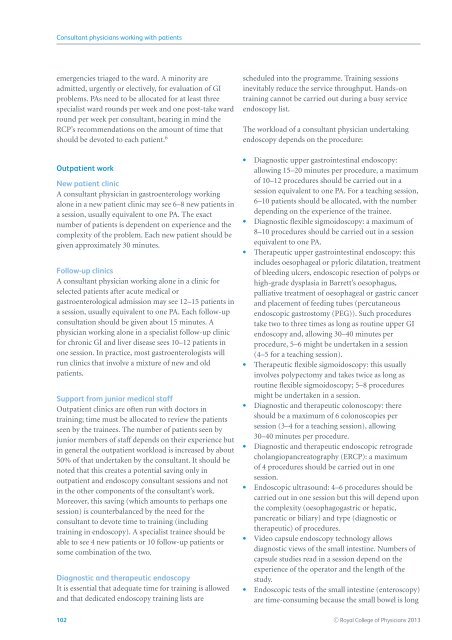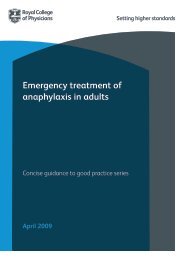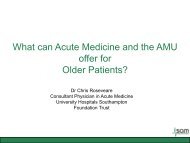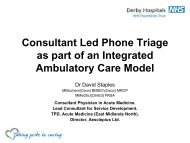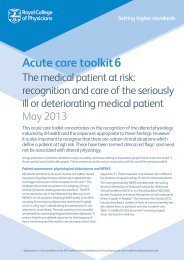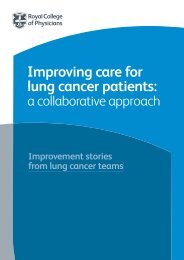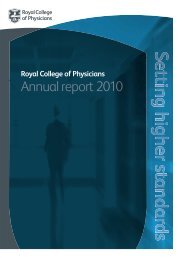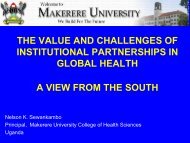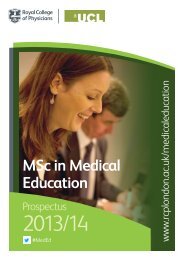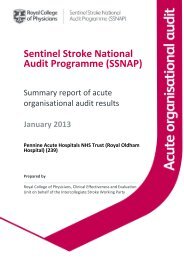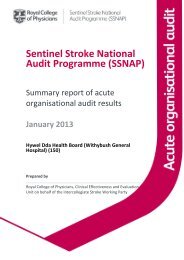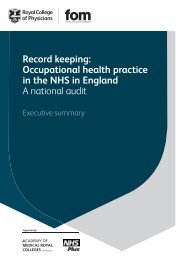Consultant physicians working with patients - Royal College of ...
Consultant physicians working with patients - Royal College of ...
Consultant physicians working with patients - Royal College of ...
Create successful ePaper yourself
Turn your PDF publications into a flip-book with our unique Google optimized e-Paper software.
<strong>Consultant</strong> <strong>physicians</strong> <strong>working</strong> <strong>with</strong> <strong>patients</strong>emergencies triaged to the ward. A minority areadmitted, urgently or electively, for evaluation <strong>of</strong> GIproblems. PAs need to be allocated for at least threespecialist ward rounds per week and one post-take wardround per week per consultant, bearing in mind theRCP’s recommendations on the amount <strong>of</strong> time thatshould be devoted to each patient. 6Outpatient workNew patient clinicA consultant physician in gastroenterology <strong>working</strong>alone in a new patient clinic may see 6–8 new <strong>patients</strong> ina session, usually equivalent to one PA. The exactnumber <strong>of</strong> <strong>patients</strong> is dependent on experience and thecomplexity <strong>of</strong> the problem. Each new patient should begiven approximately 30 minutes.Follow-up clinicsA consultant physician <strong>working</strong> alone in a clinic forselected <strong>patients</strong> after acute medical orgastroenterological admission may see 12–15 <strong>patients</strong> ina session, usually equivalent to one PA. Each follow-upconsultation should be given about 15 minutes. Aphysician <strong>working</strong> alone in a specialist follow-up clinicfor chronic GI and liver disease sees 10–12 <strong>patients</strong> inone session. In practice, most gastroenterologists willrun clinics that involve a mixture <strong>of</strong> new and old<strong>patients</strong>.Support from junior medical staffOutpatient clinics are <strong>of</strong>ten run <strong>with</strong> doctors intraining; time must be allocated to review the <strong>patients</strong>seen by the trainees. The number <strong>of</strong> <strong>patients</strong> seen byjunior members <strong>of</strong> staff depends on their experience butin general the outpatient workload is increased by about50% <strong>of</strong> that undertaken by the consultant. It should benoted that this creates a potential saving only inoutpatient and endoscopy consultant sessions and notin the other components <strong>of</strong> the consultant’s work.Moreover, this saving (which amounts to perhaps onesession) is counterbalanced by the need for theconsultant to devote time to training (includingtraining in endoscopy). A specialist trainee should beable to see 4 new <strong>patients</strong> or 10 follow-up <strong>patients</strong> orsome combination <strong>of</strong> the two.Diagnostic and therapeutic endoscopyIt is essential that adequate time for training is allowedand that dedicated endoscopy training lists arescheduled into the programme. Training sessionsinevitably reduce the service throughput. Hands-ontraining cannot be carried out during a busy serviceendoscopy list.The workload <strong>of</strong> a consultant physician undertakingendoscopy depends on the procedure: Diagnostic upper gastrointestinal endoscopy:allowing 15–20 minutes per procedure, a maximum<strong>of</strong> 10–12 procedures should be carried out in asession equivalent to one PA. For a teaching session,6–10 <strong>patients</strong> should be allocated, <strong>with</strong> the numberdepending on the experience <strong>of</strong> the trainee. Diagnostic flexible sigmoidoscopy: a maximum <strong>of</strong>8–10 procedures should be carried out in a sessionequivalent to one PA. Therapeutic upper gastrointestinal endoscopy: thisincludes oesophageal or pyloric dilatation, treatment<strong>of</strong> bleeding ulcers, endoscopic resection <strong>of</strong> polyps orhigh-grade dysplasia in Barrett’s oesophagus,palliative treatment <strong>of</strong> oesophageal or gastric cancerand placement <strong>of</strong> feeding tubes (percutaneousendoscopic gastrostomy (PEG)). Such procedurestake two to three times as long as routine upper GIendoscopy and, allowing 30–40 minutes perprocedure, 5–6 might be undertaken in a session(4–5 for a teaching session). Therapeutic flexible sigmoidoscopy: this usuallyinvolves polypectomy and takes twice as long asroutine flexible sigmoidoscopy; 5–8 proceduresmight be undertaken in a session. Diagnostic and therapeutic colonoscopy: thereshould be a maximum <strong>of</strong> 6 colonoscopies persession (3–4 for a teaching session), allowing30–40 minutes per procedure. Diagnostic and therapeutic endoscopic retrogradecholangiopancreatography (ERCP): a maximum<strong>of</strong>4proceduresshouldbecarriedoutinonesession. Endoscopic ultrasound: 4–6 procedures should becarried out in one session but this will depend uponthe complexity (oesophagogastric or hepatic,pancreatic or biliary) and type (diagnostic ortherapeutic) <strong>of</strong> procedures. Video capsule endoscopy technology allowsdiagnostic views <strong>of</strong> the small intestine. Numbers <strong>of</strong>capsule studies read in a session depend on theexperience <strong>of</strong> the operator and the length <strong>of</strong> thestudy. Endoscopic tests <strong>of</strong> the small intestine (enteroscopy)are time-consuming because the small bowel is long102 C○ <strong>Royal</strong> <strong>College</strong> <strong>of</strong> Physicians 2013


